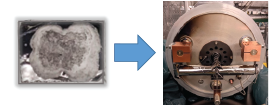Katharina Domnanich

Research
Nuclear Chemistry
(Research Description PDF)
At the Facility for Rare Isotope Beams (FRIB) a plethora of by-product radionuclides will be created that are of immense societal value for a number of disciplines, viz. nuclear medicine, plant biology, material science, astrophysics and stockpile stewardship science. It is an ambitious endeavor to collect these rare radionuclides at sub-nanomolar levels from the vast amount of cooling water, radiochemically purify them, and finally transfer them into a chemical form that is required for the specific applications. So far, the feasibility of ‘isotope harvesting’ was already probed at the National Superconducting Cyclotron Laboratory (NSCL). The next step will involve a translation towards the conditions at FRIB, where challenges like considerably increased levels of radioactivity, diluted in a greatly larger water volume will be met.

ReA-facility. The ion sources are introduced into the Batch Mode
Ion Source module (right).
Additionally, in the normal operation mode of FRIB a broad variety of multiple isotopes of each element will be created, and often direct harvesting efforts will not yield radioisotopically pure samples. Currently this limitation is addressed by focusing on the collection of so-called ‘radionuclide generator pairs’, where the decaying parent radionuclide generates the desired daughter radionuclide. An option to further increase the spectrum of available pure radioisotopes would be through the implementation of mass separation. For this task, we envision to utilize the on-site available Re-Accelerator (ReA) facility. Within this approach, the introduced isotopic mixtures will be separated according to the different mass-to-charge ratio, followed by the collection of the purified isotopes. This concept is inspired by the isotope separator facilities CERN-MEDICIS, Switzerland and TRIUMF, Canada, which pioneered this technique in the last decades. We will introduce the necessary modifications at ReA and develop mass separation capabilities for the harvested radionuclides.
Radioactive Targetry for Neutron Studies and Ion Sources – Particular focus will be directed towards collecting and separating radionuclides which are of interest for scientific studies, such as neutron reaction studies. Precise measurement of neutron capture cross sections is imperative to elucidate the processes in cosmic environments as well as to address national security questions within the framework of the Stockpile Stewardship Program Theoretical calculations of these cross sections are often afflicted with large uncertainties, as such only experimental efforts can address these data needs. However, a great challenge in the performance of neutron cross section studies with radioactive samples is to obtain the necessary amount of material (up to microgram quantities) at high radioisotopic purity. For the Stockpile Stewardship Program the isotopes of Eu, Lu and Tm are of priority, while the s-process branch-point isotopes viz. 63Ni, 79Se, 147Nd, 147,148Pm, 153Gd, 160Tb, etc. are of interest for astrophysics research. To address these nuclear data needs, we will use the obtained mass-separated samples to manufacture radioisotopically pure targets. These targets will be utilized in neutron reaction studies, where we would like to collaborate with neutron source facilities and research reactors.
Additionally, to compensate for the utilization of ReA’s mass separator, we will support the stand-alone operation of this facility by the preparation of radioactive ion sources with the harvested radionuclides. The establishment of such a synergistic approach will facilitate the development of multi-user capabilities at FRIB. For the preparation of ion sources for the ReA, a high isotopic purity is not necessary and the chemically purified radioactive solutions can be used directly, without a preceding mass separation step. The experience acquired with the neutron reaction targets will be directly translatable towards the manufacturing of ReA ion sources.

Mode Ion Source (BMIS) the introduced sample will be ionized, followed by extraction and separation
in the mass separator. A single ion beam will be selected an implanted into a collector foil, placed
inside the collection system.
Contact / Webpage
Area(s) of Interest
Nuclear (Nu)
Analytical (An)
Biological (Bi)
Inorganic (In)
Selected Publications
Harvesting krypton isotopes from the off-gas of an irradiated water target to generate 76Br and 77Br, Clause H.K., Domnanich K.A., Kleinfeldt C., Kalman M., Walker W., Vyas C., Abel E.P., Severin G.W., Sci. Rep. 2022, 12, 1433.
Harvesting 62Zn from an aqueous cocktail at the NSCL, Domnanich K.A., Vyas C.K., Abel E.P., Kalman C., Walker W., Severin G.W., New J. Chem. 2020, 44, 20861–20870.
Durability test of a flowing-water target for isotope harvesting, Abel E.P., Domnanich K.A., Kalman C., Walker W., Engle J.W., Barnhart T.E., Severin G., Nucl. Instruments Methods Phys. Res. B 2020, 478, 34-45.
Production and separation of 43Sc for radiopharmaceutical purposes, Domnanich K.A., Eichler R., Müller C., Jordi S., Yakusheva V., Braccini S., Behe M., Schibli R., Türler A., van der Meulen N.P., EJNMMI Radiopharm. Chem. 2017, 2, 14.
47Sc as useful β-emitter for the radiotheragnostic paradigm: a comparative study of feasible production routes, Domnanich K.A., Müller C., Benešová M., Dressler R., Haller S., Köster U., Ponsard B., Schibli R., Türler A., van der Meulen N.P., EJNMMI Radiopharm. Chem. 2017, 2, 5.
Cyclotron production of 44Sc: From bench to bedside, Van der Meulen N.P., Bunka M., Domnanich K.A., Müller C., Haller S., Vermeulen C., Türler A., Schibli R., Nuc Med Biol. 2015 42, 745-751.
CV
B.Sc., Dublin Inst. of Technology, Ireland
M.Sc., Univ. of Vienna, Austria; Ph.D., Univ. of Bern, Switzerland
Research Associate, National Superconducting Cyclotron Laboratory, Dept. of Chemistry, Michigan State Univ.